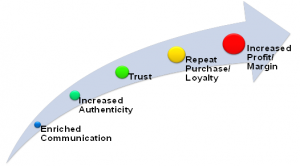
The Key that Unlocks the Art and Science of Branding
Understanding the meanings of a brand and how they should be communicated to full advantage is both an art and a science. We are adept at
- Asking the right combinations of questions;
- Using emotional, cultural and experiential techniques; and
- Conducting varied analyses that feed communications development.
Fortune 1000 companies, advertising agencies and select non-profits are our core clients.
InnerMind Metrix™ enables us to identify and measure the emotions that drive brand preference at the same time that we collect the context in which those emotions live. We convert data from online conversations as well as custom inquiries into brand insights that create a defensible place in the hearts and minds of your target customers.[/vc_column_text][/vc_column][/vc_row][vc_row][vc_column][vc_column_text]
Ingredient Branding
 Every upstream innovation needs a downstream innovation to be successful. The upstream innovation can be even more powerful with ingredient branding. Ingredient brands are those upstream products that not only add functional value, but also their logo on branded products or services adds its own brand power to the branded product. They add to customer loyalty, evoke customer preference,, and support premium price points. An ingredient brand not only adds value to a host brand’s equity, but as markets mature, it can also create or enhance differentiation.
Every upstream innovation needs a downstream innovation to be successful. The upstream innovation can be even more powerful with ingredient branding. Ingredient brands are those upstream products that not only add functional value, but also their logo on branded products or services adds its own brand power to the branded product. They add to customer loyalty, evoke customer preference,, and support premium price points. An ingredient brand not only adds value to a host brand’s equity, but as markets mature, it can also create or enhance differentiation.
How Ingredient Brands Are Born
When an upstream manufacturer develops a new breakthrough product, they diligently commercialize and promote identity in order to obtain increasing market acceptance of the product. Since it is a breakthrough, the branded product becomes accepted by direct customers and often becomes famous for the benefits it brings to the downstream market. When promoted properly, it also becomes desirable to consumers because of the publicity it generates as a source of “new” perceptions for older brand names that incorporate it into their product lines.
As a new ingredient brand becomes familiar among downstream specifiers, the name not only becomes more recognizable, but it also develops its own meaning. The ultimate constituency that fosters an iconic meaning for any brand is consumers who assign daily-life significance to it. At that point—when a labeled component of an end product like a computer or fashionable garment becomes a familiar name that influences consumers’ choices—an ingredient brand is born.[/vc_column_text][/vc_column][/vc_row][vc_row][vc_column width=”2/3″][vc_column_text]The key to achieving this marketplace status is managing the brand well beyond its functional value. Accomplishing this is much more complex than managing a consumer brand. Ingredient branders have distinct challenges which must be met in order to fully capitalize on ingredient brand potential for value. They must
- Educate their internal organization on how a brand is different from a product and the importance of building brand equity
- Effectively communicate the brand downstream from the direct customer without creating unmanageable friction with that customer
- Articulate an integrated marketing strategy with a balanced emphasis beyond product performance value to include benefits and emotional brand image that drive differentiation and preference
- Coordinate all management functions to contribute to consistent brand message—to “walk the brand walk” in all decisions. Always address brand misuse
- Capture and retain price premium, avoiding the temptation to trade off long-term premium for short-term share
In summary, apply a branding mindset at the onset of product commercialization. When doing the market validation concept research early in the product concept phase, design it not just to learn what end user respondents like or dislike about the concept, but also to capture how the respondents talk about the concept.[/vc_column_text][/vc_column][vc_column width=”1/3″][vc_basic_grid post_type=”ids” element_width=”12″ gap=”10″ item=”5092″ grid_id=”vc_gid:1596218645521-4c1fb5ae-df58-4″ include=”4233″][/vc_column][/vc_row][vc_row][vc_column][vc_column_text]
The Brand Action Model
The Brand Action Model™ (BAM) is a sociological construct that provides a unique perspective on consumer relationships to brands. It is based on elements of the best of the Sociological Community Models. By understanding the social dimensions of branding, BAM enables us to manage the impact of environmental influences and leverage them to build a brand community, complete with supportive institutions and brand partners with shared values.
For the advertising agency, this is a new model for business success. The business benefits in taking this approach include
- Building and maintaining enhanced client loyalty even in price-sensitive markets
- Creating stronger, more differentiated brand positioning
- Developing a stronger base upon which to build brand extensions
| What’s Being Done | What Should Be Done |
|---|---|
| Focusing on end user/consumer | Converting the social system of value chain intermediaries AND consumers to belief in the brand |
| Generating brand awareness and motivating behaviors of individuals | Building brand allegiance through end user/consumer influencers and institutions |
| Communications creativity | Integrated communications strategy |
| Purchasing | Evangelizing value chain members |
| Focus groups, surveys | Addition of history, ethnography, cultural anthropology, participant observation, semiotics (the theory and study of signs and symbols, especially as elements of language) |
| Primary offering: advertising | Primary offerings: Integrated Brand Promotion (IBP) Strategy and implementation |
[/vc_column_text][vc_column_text]
BAM in Action
 Every brand is part of a complex value chain. The key influencers in that chain are the people, social institutions, and business organizations that mediate between the client and the end user, as well as the cultural context of values and meanings in which both operate.
Every brand is part of a complex value chain. The key influencers in that chain are the people, social institutions, and business organizations that mediate between the client and the end user, as well as the cultural context of values and meanings in which both operate.
When consumers see a brand valued by consumers or influencers they care about, institutions they respect, and organizations they rely on to bring them products that fulfill their expectations, they value the brand all the more. When retailers or other intermediaries see the brand valued by consumers, they value it more. All parties exist in a social system in which they value each other more when they share common cultural perceptions.
This is something industries such as the beauty and fashion industries are already learning. The decline in returns provided by traditional marketing channels, combined with the excitement surrounding influencer marketing, has led to brands competing for influencers’ attention. Which influencers were considered the best was often determined by follower count or a “cool factor,” rather than meaningful analytics; but it may be time to revisit the way brands look at influencers. While influencers have demonstrated that they can generate tremendous value, brands needs to differentiate between fame and actual influence. Influencers aren’t celebrities; they are actually a commodity.
When a brand’s cultural meanings are embedded into consumer and intermediary cultures, then you have created a brand community. That community can be mobilized to amplify, protect, and extend that brand’s meanings to current and new constituents. We do that by creating and using the tools below to develop unique insights about the brand’s consumers, intermediaries, and cultural context:
- African-American consumer goods
- Culturally defined anthropological databases
- Customer sociological segmentation that goes beyond traditional demographics and psychographics
- When needed, particular research tailored to identify the cultural significance of a brand’s equity
By taking a social systems approach, we create multiple connections among the brand, the value chain intermediaries, and the consumer. This brand community can be used to create unique, multi-dimensional value propositions for clients’ brands and brand families.[/vc_column_text][/vc_column][/vc_row][vc_row][vc_column][vc_column_text]
Read more about brand discovery.
[/vc_column_text][vc_empty_space height=”20px”][vc_basic_grid post_type=”ids” item=”5092″ grid_id=”vc_gid:1596218540089-f0861b0d-db05-5″ include=”5134, 3870″][/vc_column][/vc_row][vc_row][vc_column][vc_column_text]
™Brand Action Model is a trademark of Breakthrough Marketing Technology, LLC™InnerMind Metrix is a trademark of Breakthrough Marketing Technology, LLC
[/vc_column_text][/vc_column][/vc_row][vc_row][vc_column][vc_empty_space height=”50px”][/vc_column][/vc_row]


